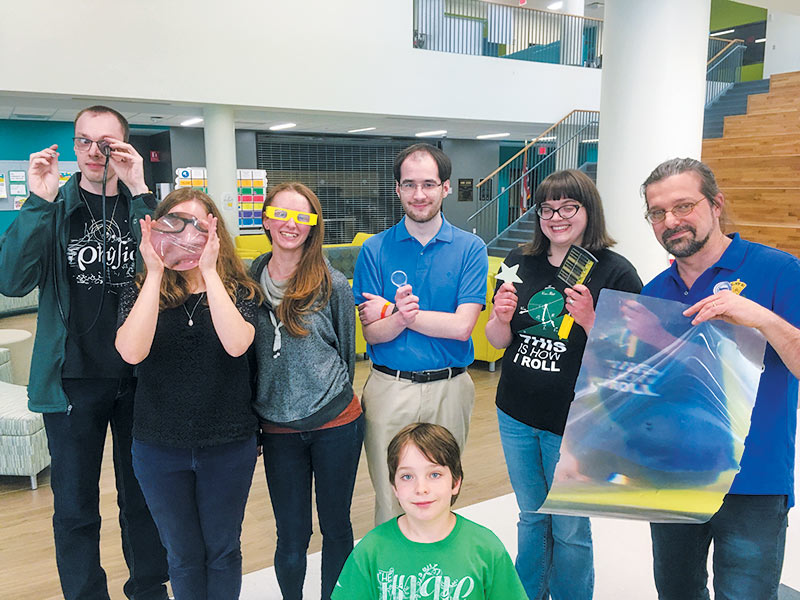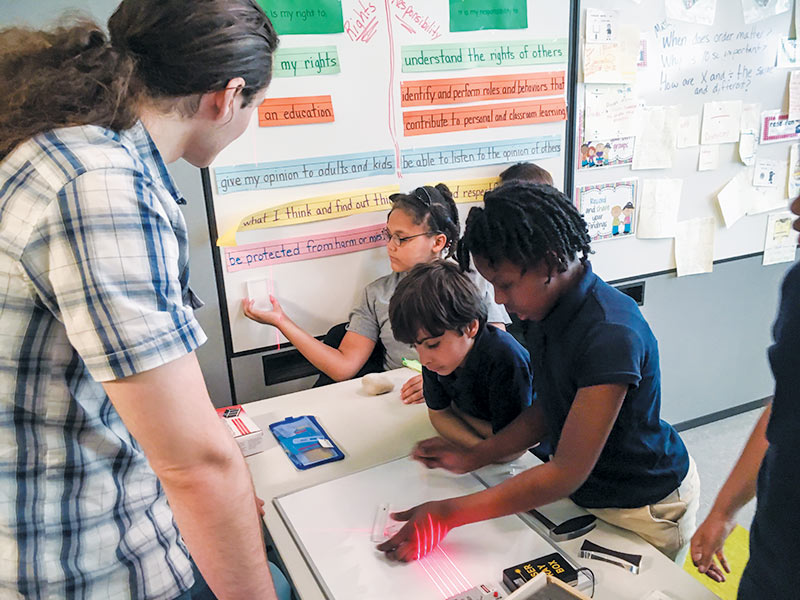Lunchtime Physics Club for True Inquirers
Lunchtime Physics Club for True Inquirers
2017–18 Marsh White Award
Project Leads: Samantha Tietjen & Jim Pitchford
Project Advisor: Kiril A. Streletzky
Project Summary: The 2017 school year saw the opening of Campus International School’s (CIS) brand-new building, and with it several new student programs. Cleveland State University’s (CSU) SPS was asked to help with the Programme of Inquiry, a K-5 grade educational structure focusing on globally minded, investigation-based lessons and learning with a specific focus on “How the
World Works.”
 Our chapter delivered outreach lessons during three after-school visits referred to as Physics Fridays and one school-day visit. In order to follow the progression of the Programme of Inquiry as closely as possible, we designed and delivered lessons in the following order: Center of Mass/Intro to Simple Machines, Density/Phase Changes, and Light/Optics. Each station engaged students with a basic demo followed by hands-on activities of increasing complexity through the lesson.
Our chapter delivered outreach lessons during three after-school visits referred to as Physics Fridays and one school-day visit. In order to follow the progression of the Programme of Inquiry as closely as possible, we designed and delivered lessons in the following order: Center of Mass/Intro to Simple Machines, Density/Phase Changes, and Light/Optics. Each station engaged students with a basic demo followed by hands-on activities of increasing complexity through the lesson.
The first visit featured lessons on density and Newtonian forces as demonstrated by simple machines. In the density station, students were presented with objects of varying densities and encouraged to investigate how the objects behaved in water. Two separate stations focused on simple machines: one on the small scale, where students were given parts and allowed to construct their own machines to test, and another with large simple machines, including pulley and lever systems. Our second visit focused on different states of matter and started with basic experiments of freezing and melting of water. We then ventured beyond standard phase changes by inflating a balloon through dry ice sublimation and studying the mystery of an “instant freezing water bottle.”1 The true highlight of the lesson was introducing items like “boiling” soda, marshmallows, balloons, and dry ice into a vacuum and asking students to decide which were and weren’t examples of phase change and why. The last after-school visit was all about optics and light. We asked students to recall what they know about waves and if they knew how this related to light.
The demos for this visit included stations such as dispersion of light, geometrical optics, light and energy, and reflection/refraction. The students raved about this lesson, particularly because they were able to use lasers.
One Programme of Inquiry topic that we weren’t initially sure how to incorporate into our lessons was environmental science and biological processes. The answer came to us in the form of a Foldscope2—a high-powered paper microscope that is assembled origami style and able to view things very clearly with a magnification of up to 140X and 2 μm resolution. During the lesson, students once again got to play with the laser box and lenses, compare a Foldscope to a standard microscope, and build one of the Foldscopes. Students were also shown some of the attachments that can go with the scopes, including a projector and a camera mount for a phone or tablet.
Over the course of the project, we reached 15–35 students in grades K-5 per event through each of the after-school Physics Friday program visits and 24 fourth-grade students through the school-day visit. Now that the first year has been completed, several other teachers in the school have already asked us to plan a similar sort of program for their classrooms. The goal for this project was to expand our audience from just the after-school Physics Friday program by starting an in-school science club for students. While we had hoped to get to more in-school visits, there were several issues with scheduling that kept us from going as often as we planned. Regardless, the students’ enthusiasm made it clear that our in-school visit impacted students who are not as regularly exposed to hands-on learning. This bodes well for the program, and, hopefully, after several more classroom visits we will be able to transfer it to a full-on science club as originally intended! 
1. Check out the instant freezing water bottle at https://www.stevespanglerscience.com/lab/experiments/instant-freeze-soda-ice/.
2. To learn more about Foldscopes, visit https://www.foldscope.com/.
To learn more about this project, visit spsnational.org/awards/marsh-w-white-outreach-award/2018/cleveland-state-university.
